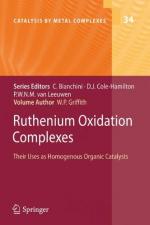|
This section contains 356 words (approx. 2 pages at 300 words per page) |
Ruthenium belongs to the platinum group of metals found in the middle of Rows 5 and 6 of the periodic table. Its atomic number is 44, its atomic mass is 101.07, and its chemical symbol is Ru.
Properties
Ruthenium is a hard, silvery white metal with a shiny surface and a melting point of 4,172-4,442°F (2,300-2,450°C), a boiling point of about 7,052-7,500°F (3,900-4,150°C), and a density of 12.41 grams per cubic centimeter. It is a relatively inert element that does not react with oxygen, most acids, or aqua regia (a mixture of concentrated nitric acid and 3-4 parts of hydrochloric acid).
Occurrence and Extraction
Ruthenium is one of the rarest elements on Earth with an abundance estimated at about 0.4 parts per billion. It usually occurs in combination with other members of the platinum family in ores of platinum. It is obtained as a byproduct of the purification of those ores and during the refining of nickel metal.
Discovery and Naming
Ruthenium was "discovered" at least three times in the first half of the nineteenth century. The first discovery was made by the Polish chemist Jedrzej Sniadecki (1768-1838) in 1808. Sniadecki suggested the name vestium for the element in honor of the asteroid Vesta. Sniadecki's work could not be confirmed by other chemists, however, and he eventually dropped his claim to having found the element. About 20 years later, this scenario was repeated when the Russian chemist Gottfried W. Osann again found element 44. Once again, Osann's discovery could not be confirmed and his claim was rejected. Finally, in 1844, the Russian chemist Carl Ernst Claus (1796-1864) was able to show conclusively that element 44 existed and it was the same element that both Sniadecki and Osann had found. Claus suggested the name of ruthenium for the element after the ancient name of Russia, Ruthenia.
Uses
The most important single use of ruthenium is in the manufacture of alloys with platinum or palladium. Ruthenium adds hardness and resistance to corrosion to such alloys. They are used to make electrical contacts, medical instruments, and some types of very expensive jewelry. Ruthenium is also used to make catalysts for research and industrial applications.
|
This section contains 356 words (approx. 2 pages at 300 words per page) |


